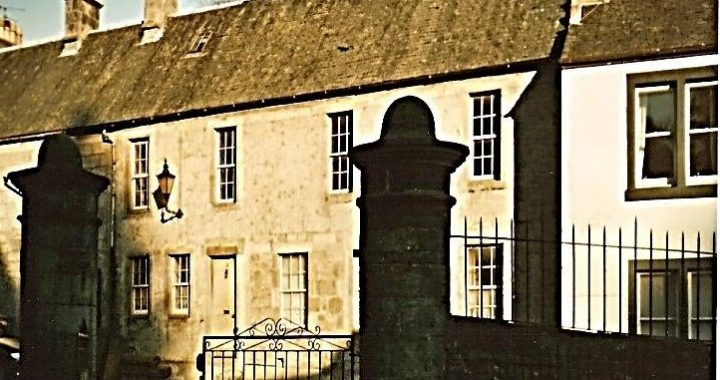The first Barbour manufacturer and linen merchant in Kilbarchan was Baillie John Barbour (1701-c1770). He married Janet Fulton in 1726 and had three sons and four daughters. Their first house was in Church Street. (See image above.)
As a Baillie (judicial officer of a Barony) John Barbour was a man of importance and influence in the village. John’s brothers, William and Robert were partners in the family concern.
John was also an entrepreneurial businessman and his linen manufactury was not his only commercial enterprise in Kilbarchan. In the 1740s he owned a candle factory in the village which exported large batches of candles to the West Indies in the 1740s.
By 1739 Baillie John Barbour had built a weaving manufactory in the village, originally for the manufacture of thick linen, and soon after built a bleaching factory. He engaged local weavers, who worked looms in their own homes, and business prospered. The Barbours, like the Speirs, exported their fine linen goods to Dublin and London. In the late 1750s Robert Barbour, John’s brother, was responsible for the export trade. As a packman or commercial traveller, Robert conducted business, not only for the Barbours, but also for other Kilbarchan and some Paisley manufacturers.
Baillie John’s sons, John, William and Humphrey, joined the family business and after the death of their father, the three brothers expanded the family business. The Barbours, like the Speirs, had established premises in Dublin. Both Baillie John’s eldest son, known locally as John of Law, and the youngest son, Humphrey, divided their interests between Kilbarchan and Ireland. William, the second son, attended to the weaving and bleaching business at home.
Although the Barbours’ main exports were finished textiles, from the 1770s Humphrey Barbour was also a thread (as opposed to textile) manufacturer in Kilbarchan. Humphrey used superior linen yarn imported from Ulster and the Barbours exported the finished thread back to Ireland. One large consignment of 276 lbs. of unrated Scotch thread and 12 lbs. of filler thread, along with 4848 yards of plain lawns, leno, cambric and catgut, 152 yards ornamented with cotton, was shipped to Dublin by the Barbours in November, 1784.
By the 1780s, with the gradual demise of the linen trade in Scotland, the Barbours continued to concentrate their main interests in Ireland and a third generation John Barbour moved to Lisburn where he set up a factory settlement for spinning thread on Plantation Stream in 1784. A dam was built on the stream, and his twisting mill, driven by animal powered machinery, was a large circular building 33 ft. in diameter and seven to eight feet high. Two factory buildings, two factory houses and two blocks of workmen’s houses completed the site.
The Barbours’ commercial interests in Kilbarchan had ended by 1800. Humphrey had moved to Glasgow as a wine merchant; John died in 1794; and William’s bleaching business in Kilbarchan failed in 1799. However, that is by no means the end of the Kilbarchan Barbour story! Humphrey’s family founded very successful businesses in Manchester and Liverpool; William Barbour, the son of the John Barbour who built the thread mill at Plantation in Lisburn, was the founder William Barbour and Sons, which became a world-wide concern, and rivalled Coats of Paisley.
© 2022 Helen Calcluth
Further information on the Speirs, Barbours, Hows and Houstons is contained in “Kilbarchan and the Handloom Weavers” (Chapter 3, pp 31-42). Available on the website Publications.

